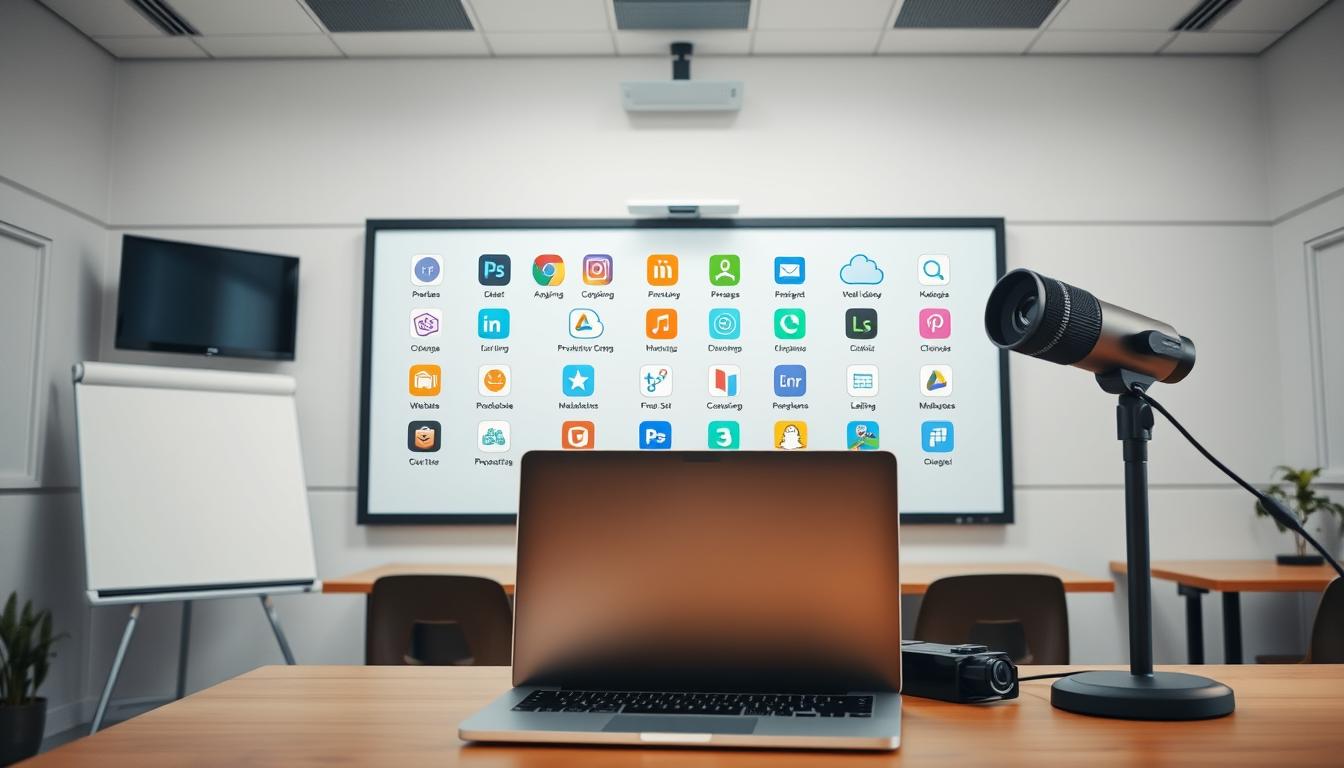Essential Tools and Software for Virtual School Success
Have you ever wondered how modern technology is reshaping the way students learn and teachers teach? In today’s digital age, the right software and tools can make all the difference in creating an effective and engaging learning environment.
From communication platforms to lesson planning software, these resources are transforming education. Teachers can now manage their classrooms more efficiently, while students gain access to interactive materials and real-time feedback.
In this guide, we’ll explore the essential tools that power modern education. Whether you’re an educator, student, or parent, you’ll discover how these innovations can enhance the learning experience and prepare students for success.
Introduction to Virtual School Tools
The way we approach education has transformed dramatically in recent years. With the rise of digital platforms, students and teachers now have access to resources that make learning more interactive and accessible than ever before.
Our Evolving Virtual Learning Landscape
Traditional classrooms are no longer the only option for education. Today, digital environments allow students to connect with teachers from anywhere in the world. Platforms like Google Classroom and Zoom have become essential, offering features that support real-time communication and collaboration.
These tools provide a seamless way to share materials, conduct lessons, and give feedback. They also enable educators to create engaging content that keeps students motivated and focused.
Why Tools Matter in Today’s Education
In modern education, the right tools can make a significant difference. They help teachers manage their classes more efficiently and ensure students have access to high-quality resources. From interactive whiteboards to learning management systems, these platforms are designed to enhance the learning experience.
Understanding how to use these tools effectively is crucial for educators. It allows them to create dynamic lessons and foster a more inclusive and engaging environment for their students.
Understanding Distance Learning and its Impact
Education has evolved beyond physical classrooms, embracing digital solutions that redefine how we learn. Distance learning has become a cornerstone of today’s educational landscape, offering flexibility and accessibility to students and teachers worldwide.
What Is Distance Learning?
Distance learning refers to educational methods that allow students to learn remotely, without being physically present in a classroom. It includes both asynchronous and synchronous methods. Asynchronous learning lets students access materials and complete tasks at their own pace, while synchronous learning involves real-time interaction through platforms like Zoom or Google Classroom.
This approach goes beyond traditional teaching, leveraging video lessons, interactive modules, and collaborative tools. It ensures that students can connect with teachers and peers, regardless of geographical barriers.
The Benefits of Going Digital
Distance learning offers numerous advantages that enhance the learning experience. Here are some key benefits:
- Flexibility: Students can learn at their own pace, balancing education with other commitments.
- Accessibility: It provides opportunities for learners in remote areas or with special needs.
- Time-Saving: Eliminates the need for commuting, allowing more focus on studies.
- Interactive Resources: Platforms offer engaging materials like quizzes, videos, and whiteboards.
Technology plays a vital role in overcoming challenges related to remote education. It ensures seamless communication, resource sharing, and feedback, creating a dynamic and inclusive learning environment. For more insights into personalized learning experiences, explore our detailed guide.
Essential Features of Modern Virtual Classrooms
Digital innovations are shaping the future of education by making classrooms more interactive and secure. These platforms offer features that enhance both teaching and student engagement, ensuring a seamless learning experience.
Interactive Lesson Plans and Real-Time Feedback
Modern platforms support interactive lesson plans that keep students engaged. Tools like digital whiteboards allow teachers to create dynamic presentations. Students can participate in real-time, answering questions and completing quizzes.
Real-time feedback is another key feature. Teachers can instantly assess student understanding and adjust lessons accordingly. This ensures that every student stays on track and receives the support they need.
Secure and Accessible Learning Environments
Security is a top priority in today’s digital classrooms. Advanced software incorporates protocols to protect sensitive data. This ensures a safe environment for both students and teachers.
Accessibility is equally important. Platforms like Google and Zoom offer seamless interfaces that cater to diverse needs. This makes learning inclusive and convenient for everyone.
Here are some key features that make modern classrooms effective:
- Interactive Tools: Digital whiteboards and quizzes enhance engagement.
- Real-Time Feedback: Instant assessments help teachers guide students effectively.
- Secure Platforms: Robust protocols protect sensitive information.
- Accessible Interfaces: User-friendly designs ensure inclusivity.
These features collectively enhance the teaching and learning process, making education more effective and enjoyable.
Virtual School Tools for Student Success
In today’s digital era, the right resources can transform how students achieve their academic goals. Selecting the best platforms and integrating them effectively ensures a seamless and productive learning experience.
Selecting the Right Tool for Every Need
Choosing the right platform is crucial for student success. Educators should evaluate tools based on specific needs, such as interactive features, ease of use, and compatibility with existing systems. For example, Google Classroom and Edmodo are popular for their ability to streamline lesson plans and provide real-time feedback.
Here are some criteria to consider when selecting tools:
- Personalization: Tools should cater to individual learning styles and paces.
- Engagement: Interactive quizzes and video lessons keep students motivated.
- Accessibility: Platforms must be user-friendly and inclusive for all learners.
Integrating Platforms for a Seamless Experience
Integration is key to creating a cohesive learning environment. Combining platforms like Zoom, Google Classroom, and learning management systems ensures smooth transitions between activities. For instance, teachers can share materials on Google Drive while conducting live sessions on Zoom.
Successful integration enhances classroom efficiency. It allows educators to focus on teaching rather than managing multiple tools. Regularly assessing the effectiveness of these platforms ensures they continue to meet student needs.
Here are some tips for seamless integration:
- Interoperability: Choose tools that work well together, such as Google Workspace and Edmodo.
- Training: Provide educators with the necessary training to use these platforms effectively.
- Feedback: Gather input from students and teachers to improve the learning experience.
By selecting and integrating the right tools, educators can create a dynamic and supportive environment that fosters student success.
Top Tools and Platforms Transforming Online Learning
The digital revolution has brought a wave of innovative platforms reshaping how education is delivered. These tools are designed to enhance interactivity, streamline management, and improve communication between teachers and students. By integrating seamlessly with existing systems, they create a cohesive learning environment that benefits everyone involved.
Highlighting Leading Software Solutions
Several platforms stand out for their ability to transform online learning. Google Classroom, for instance, simplifies lesson planning and provides real-time feedback. It’s a favorite among educators for its user-friendly interface and seamless integration with other Google tools.
Prodigy Math Game takes a unique approach by gamifying math lessons. It engages students with interactive quizzes and challenges, making learning fun and effective. Pear Deck, on the other hand, enhances presentations by allowing teachers to create interactive slides that keep students engaged.
Zoom has become a cornerstone of online classrooms, offering video conferencing features that support real-time interaction. Its breakout rooms and polling tools make it ideal for collaborative learning. These platforms are not just tools; they are essential components of a modern learning ecosystem.
Here’s why these tools are favored by educators worldwide:
- Interactivity: Features like quizzes and gamification keep students engaged.
- Ease of Use: Intuitive interfaces ensure both teachers and students can navigate them effortlessly.
- Integration: They work well with existing systems, creating a seamless experience.
Enhancing Communication and Collaboration in Virtual Classrooms
Effective communication is the backbone of any successful learning environment. In digital classrooms, the right tools and platforms ensure seamless interaction between teachers, students, and parents. These resources foster collaboration, making lessons more engaging and productive.
Effective Digital Communication Channels
Clear communication is essential for a connected classroom. Platforms like Zoom and ClassDojo provide features that streamline interactions. Teachers can share updates, conduct live sessions, and offer feedback in real-time. These tools minimize clutter, ensuring discussions stay organized and focused.
Here’s how these platforms enhance communication:
- Real-Time Interaction: Video conferencing tools like Zoom allow instant communication, making lessons more dynamic.
- Organized Messaging: Dedicated platforms reduce the chaos of emails, keeping conversations clear and structured.
- Parent Involvement: Tools like ClassDojo enable parents to stay informed about their child’s progress.
Facilitating Group Discussions and Peer Learning
Collaboration is a cornerstone of modern education. Tools that support group projects and peer-to-peer learning create a more interactive experience. Breakout rooms, for example, allow students to work in smaller teams, fostering deeper discussions.
Structured feedback is another critical component. Teachers can provide guidance, helping students refine their ideas and improve their work. This approach ensures every student feels supported and engaged.
Here are some ways to enhance collaboration:
- Group Projects: Platforms with co-editing features let students work together on shared documents.
- Breakout Rooms: These smaller spaces encourage focused discussions and teamwork.
- Feedback Systems: Regular check-ins and assessments help students stay on track.
Optimizing Digital Resources and Learning Management Systems
Learning Management Systems (LMS) are revolutionizing how educators organize and deliver lessons. These platforms provide a centralized hub for managing content, tracking progress, and enhancing student outcomes. By optimizing digital resources, teachers can create a more efficient and engaging learning environment.
Streamlining Content Delivery and Management
An effective LMS simplifies content delivery by organizing materials in one accessible location. Teachers can upload lesson plans, videos, and presentations, ensuring students have everything they need. This approach saves time and reduces the hassle of managing multiple platforms.
Modern LMS platforms also support real-time updates. Educators can quickly add new resources or modify existing ones, keeping lessons current and relevant. This flexibility is especially valuable in dynamic learning environments.
Leveraging LMS for Better Student Outcomes
LMS platforms offer tools that enhance student performance. Features like assignment tracking and automatic grading provide instant feedback, helping students stay on track. Teachers can also monitor progress and identify areas where additional support is needed.
Here’s a comparison of key LMS functionalities:
| Feature | Benefit |
|---|---|
| Assignment Tracking | Helps teachers monitor student progress |
| Real-Time Grading | Provides instant feedback to students |
| Content Organization | Streamlines access to learning materials |
| Progress Reports | Identifies areas for improvement |
By leveraging these features, educators can create a more personalized and effective learning experience. The right LMS not only simplifies teaching but also empowers students to achieve their full potential.
Advanced Equipment and Post-Production Tools for Educators
Creating a professional and engaging learning environment requires more than just software; it demands the right hardware and post-production tools. These resources ensure that lessons are clear, polished, and impactful, helping teachers connect with students effectively.
Hardware Essentials for a Robust Virtual Setup
High-performance devices are the foundation of any successful digital classroom. A reliable computer with sufficient processing power is essential for running multiple applications smoothly. Pairing it with an HD webcam, like the Logitech Brio 4K, ensures that video quality is crisp and professional.
Audio clarity is equally important. External microphones, such as the Blue Yeti, eliminate background noise and deliver clear sound. Proper lighting and a clutter-free background further enhance the visual appeal, keeping students focused on the lesson.
Using Video and Audio Editing Tools to Enhance Lessons
Post-production software can transform raw recordings into polished lessons. Tools like Adobe Premiere Pro allow teachers to edit videos, add captions, and incorporate engaging visuals. For audio, Audacity is a cost-effective solution that enhances sound quality and removes distractions.
These tools not only improve the quality of lessons but also save time in the long run. By investing in reliable equipment and software, educators can create a more immersive and effective learning experience for their students.
Here are some practical tips for selecting the right tools:
- Prioritize Quality: Choose devices and software that deliver professional results.
- Consider Budget: Look for cost-effective options that meet your needs without breaking the bank.
- Test Before Use: Ensure compatibility with your existing setup to avoid technical issues.
By focusing on advanced equipment and post-production tools, teachers can elevate their lessons and create a more engaging environment for students.
Conclusion
The integration of modern technology in education has opened new doors for both teachers and students. By leveraging the right platforms and resources, educators can create dynamic and engaging lessons that cater to diverse learning needs. Tools like Google Classroom and interactive lesson plans ensure that students stay motivated and achieve their full potential.
Adapting to evolving technologies is essential for maintaining a competitive edge in education. Teachers should continually explore innovative solutions to enhance their classroom experience. This not only improves student outcomes but also fosters a more inclusive and connected learning environment.
We remain committed to empowering educators and students through strategic technology integration. By embracing these advancements, we can ensure enduring success in the ever-changing landscape of education.







